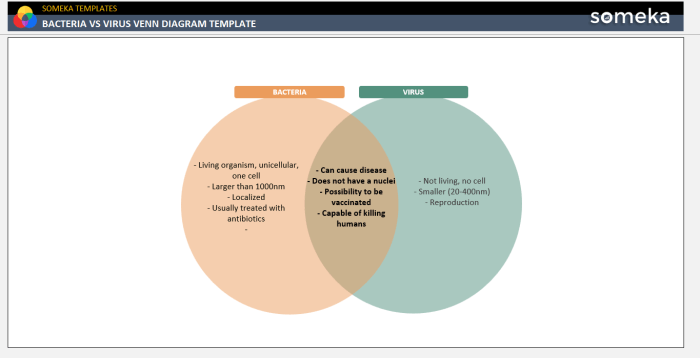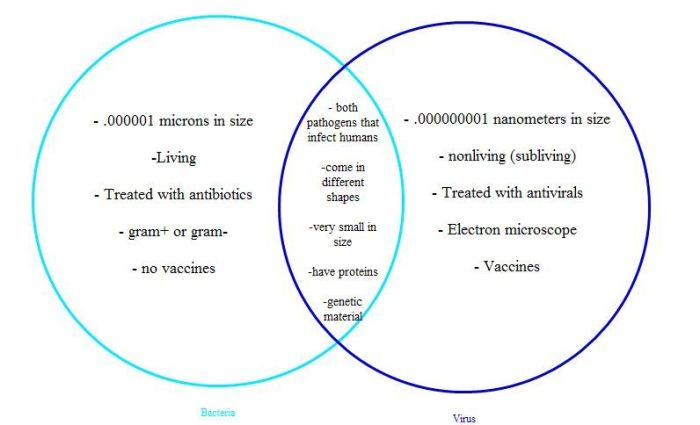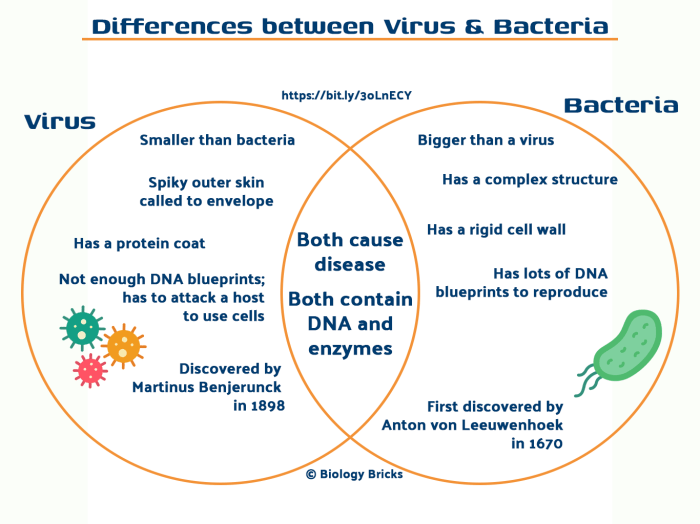Introducing the virus and bacteria venn diagram, a visual representation that unveils the intricate similarities and distinctions between these two enigmatic entities. By delving into the realms of virology and bacteriology, we embark on a journey to comprehend the fundamental differences that set apart viruses and bacteria.
The subsequent paragraphs will meticulously dissect the characteristics of each group, employing the venn diagram as a guiding framework. Examples will be strategically incorporated to illustrate the practical implications of these distinctions, solidifying our understanding of the microbial world.
Introduction

Viruses and bacteria are two distinct types of microorganisms that can cause disease in humans and other animals. However, there are several key differences between the two.
Viruses are not cells, but rather consist of a protein coat that encloses a core of genetic material. Bacteria, on the other hand, are single-celled organisms that have a cell wall, a cell membrane, and cytoplasm.
Differences between viruses and bacteria
- Viruses are much smaller than bacteria, with a diameter of about 20-300 nanometers compared to 1-10 micrometers for bacteria.
- Viruses are obligate parasites, meaning that they can only replicate inside the cells of a host organism. Bacteria, on the other hand, can be either parasites or saprophytes, meaning that they can live and grow on dead or decaying organic matter.
- Viruses do not have a metabolism of their own, and they rely on the host cell’s machinery to replicate. Bacteria, on the other hand, have their own metabolism and can produce their own energy.
- Viruses are not susceptible to antibiotics, which are drugs that kill bacteria. This is because antibiotics target the cell wall or other structures that are not present in viruses.
Venn Diagram

Similarities and Differences between Viruses and Bacteria, Virus and bacteria venn diagram
Viruses and bacteria are both microorganisms that can cause disease, but they are very different in structure and function. The following Venn diagram compares and contrasts viruses and bacteria:

Similarities between viruses and bacteria:
- Both viruses and bacteria are microorganisms that can cause disease.
- Both viruses and bacteria can be transmitted through contact with an infected person or animal, or through contact with contaminated objects.
- Both viruses and bacteria can multiply rapidly inside the body.
Differences between viruses and bacteria:
- Viruses are not cells, while bacteria are cells.
- Viruses are much smaller than bacteria.
- Viruses do not have the ability to reproduce on their own, while bacteria do.
- Viruses are typically treated with antiviral medications, while bacteria are treated with antibiotics.
Examples

Viruses and bacteria are two distinct types of microorganisms with different characteristics and modes of infection. Here are some examples of viruses and bacteria and how they fit into the Venn diagram:
Viruses
- Influenza virus:Causes the flu and is spread through respiratory droplets.
- HIV:Causes AIDS and is spread through bodily fluids.
- Ebola virus:Causes Ebola fever and is spread through contact with infected bodily fluids.
Bacteria
- Escherichia coli (E. coli):Found in the gut and can cause food poisoning.
- Staphylococcus aureus:Found on the skin and can cause infections such as pneumonia and sepsis.
- Streptococcus pneumoniae:Found in the respiratory tract and can cause pneumonia and meningitis.
Overlap
Viruses and bacteria share some similarities, such as their ability to cause disease. However, they also have significant differences, including their structure, replication, and mode of transmission.
Conclusion: Virus And Bacteria Venn Diagram

In conclusion, viruses and bacteria are distinct microorganisms with significant differences in their structure, reproduction, and pathogenicity. Understanding these differences is crucial for effective diagnosis, treatment, and prevention of infectious diseases. Viruses are obligate intracellular parasites that rely on host cells for replication, while bacteria are independent organisms capable of growth and reproduction outside of host cells.
The type of nucleic acid (DNA or RNA) present in the microorganisms, as well as the presence or absence of cell organelles, further distinguishes them. Recognizing the distinct characteristics of viruses and bacteria allows for targeted therapeutic approaches, such as antiviral drugs for viral infections and antibiotics for bacterial infections.
Answers to Common Questions
What is the primary difference between a virus and a bacterium?
Viruses are acellular entities that require a host cell to replicate, while bacteria are single-celled organisms capable of independent growth and reproduction.
Can viruses be beneficial?
Yes, some viruses, known as bacteriophages, can infect and kill bacteria, making them potential allies in the fight against bacterial infections.
How does the venn diagram help us understand viruses and bacteria?
The venn diagram provides a visual representation of the shared and distinct characteristics of viruses and bacteria, facilitating a comprehensive comparison and contrast.

